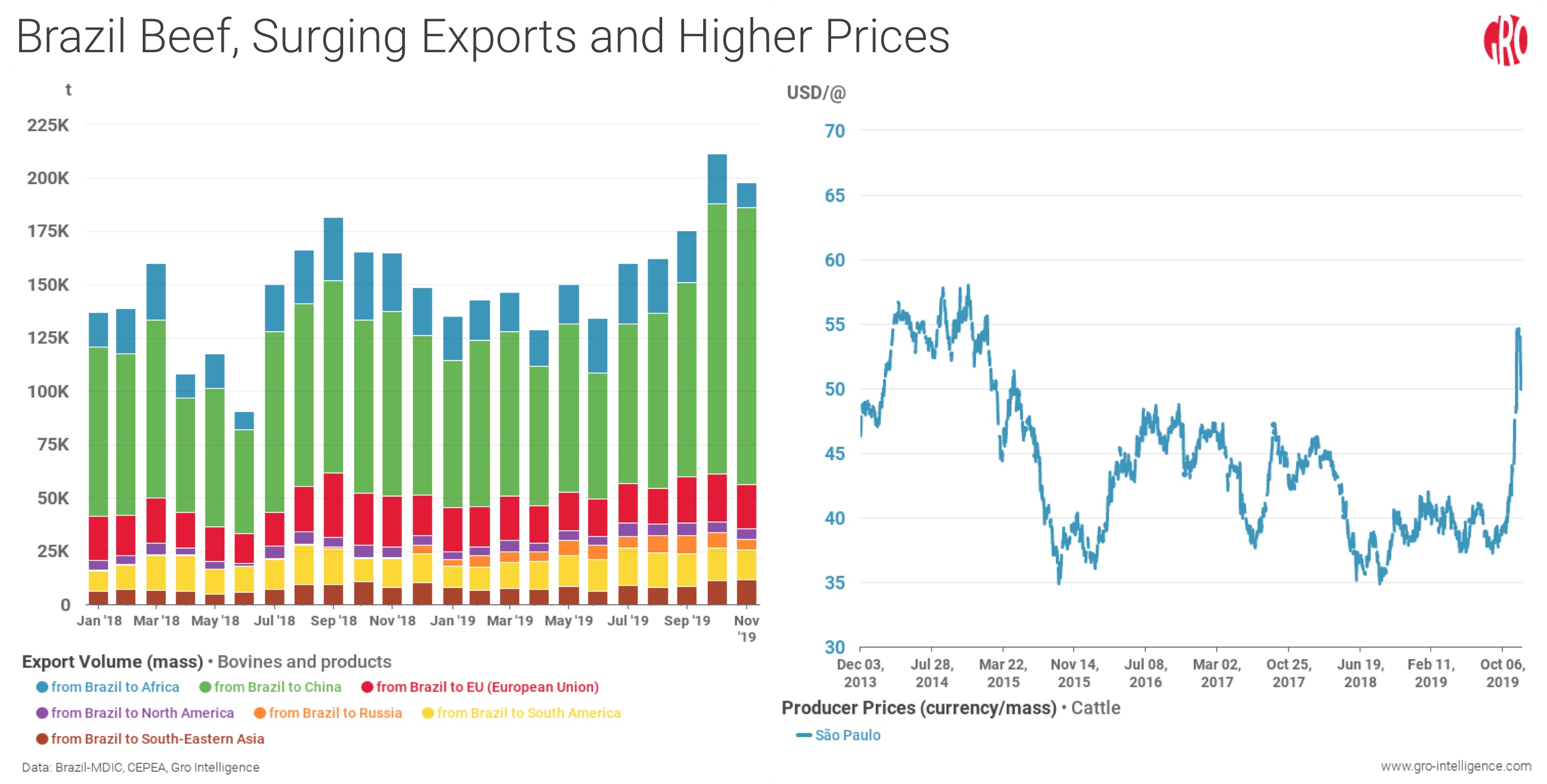Beef Exportation From Brazil to China
11 December 2019
Brazil's beef exports have jumped this year, boosted by the weakness of the country's currency. But in the past two months, beef exports have exploded, as China ramps up imports of meat to make up for its own depleted supplies.
African swine fever has decimated China's pig population, and the country is combing the world for alternative sources of meat. Brazil's stepped-up exports have caused beef shortages at home, and pushed prices to record levels in reals, the domestic currency. (See charts below with data from Brazil-MDIC and CEPEA.)
A Gro Intelligence analysis shows that Brazil beef prices could rise significantly more and still be attractive to Chinese importers. But market conditions are volatile, so Gro users should keep a close eye on relative Brazil-China prices and follow trade flow statistics in order to better forecast the supply and demand balance and future price implications.

Brazil's beef exports rose to record levels in 2019, with shipments surging in the past two months. (Stacked bars in the left chart show exports by destination.) That, in turn, has caused a spike in Brazilian beef prices (right chart). Weakness in the Brazilian currency, the real, coupled with strong demand from China has increased interest in Brazilian beef. Click on the image to go to an interactive display on the Gro web app.
Brazil's beef exports to China jumped by 52% in October and November from the same period a year ago, bringing the total so far this year to 931,000 tonnes, according to customs data from Brazil's Ministério do Desenvolvimento, Indústria, e Comércio Exterior (MDIC). Brazil's exports are up 15% in 2019 to destinations other than China.
China is buying any beef it can find. Australian beef exports to China jumped to consecutive records in October and November, and are up 81% to 265,800 tonnes so far in 2019, according to Australia's Department of Agriculture. Domestic beef prices in Australia have risen more than 50% from this time last year.
China appears to be gearing up for bigger purchases from Brazil, already the world's biggest beef exporter. The number of Brazilian beef suppliers that Beijing has authorized to ship to China rose to 37 this month from 15 in August, according to the Brazilian Association of Meat Exporting Industries (ABIEC). Additional suppliers could receive authorization after Chinese officials visit Brazil starting Dec. 15 to help local meat packers handle the necessary documentation, ABIEC says.
Brazilian beef exports to China could become even more competitive if Beijing lowers or removes a 24% import levy on South American meat. (By contrast, US beef is subject to a 47% import tariff to China.)
Beef production in Brazil is forecast to expand 5.8% in 2020, according to USDA PS&D data, the fastest pace since 2005. But if export demand exceeds expectations, the Brazilian industry will need to produce even more or risk further spikes in domestic beef prices.
Our analysis of data in Gro shows that Chinese importers can still make money even if Brazil beef prices continue to rise. Data from JCI China, an economic and agricultural information provider, shows beef cattle prices in China range from US$5.40 to $6.40 per kilogram, depending on the location. That's well above levels in Brazil, where fed cattle are priced at US$3.40 per kilogram, according to data from CEPEA, a Brazilian data source.
After factoring in freight rates, and China's 24% import tariff on South American meat, the result is $4.60 per kilogram, still below Chinese domestic prices. Of course, there are other costs associated with beef importing and processing to get a true margin. But the higher beef prices in China suggest the current surge in Brazil's cost of cattle will not deter demand from its largest export destination.
These prices are quite changeable, and the impact of African swine fever in China is dynamic. But market participants can continue to monitor the situation using data on the Gro platform.
Another key variable to watch is weather conditions for Brazil's grazing pastures. This will impact the country's ability to increase its cattle supply, since 90% of the cattle in Brazil are grass fed on pasture land. Any disruption to Brazil's ambitious plan to expand its herd by nearly 6% in 2020 could exacerbate beef shortages and high prices. Currently, evapotranspiration data in Gro indicate mostly normal conditions for this time of year.

Related Insights from Gro Intelligence:
How African Swine Fever in China Is Shaking Up World Trade Flows
Brazil Heads for Record Soybean Crop Amid Plans for Further Expansion
China's Layer-Chicken Population to See Rapid Growth, Gro Data Shows
As China's Pig Herd Shrinks, US Gears Up to Fill Global Pork Shortages
More Countries Battle African Swine Fever
US Seen Losing Out to Brazil as World Beef Demand Grows
Source: https://gro-intelligence.com/insights/monitoring-brazilian-beef-supplies-with-gro-as-china-strains-demand
0 Response to "Beef Exportation From Brazil to China"
Post a Comment